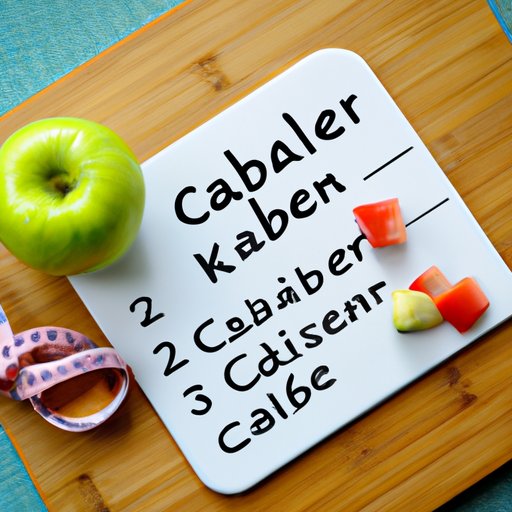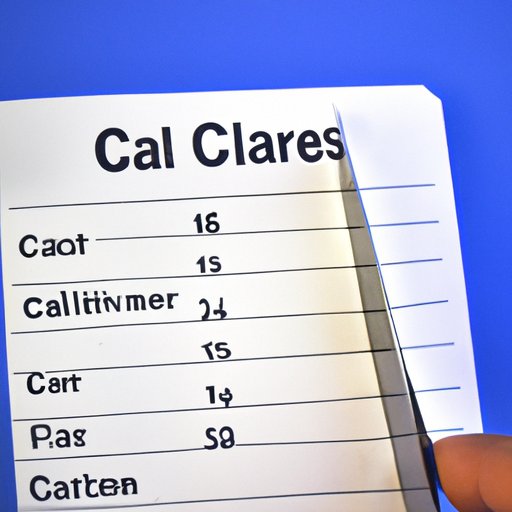Introduction
Cutting calories is a popular way to promote weight loss. But how many calories should you eat to cut? This article provides an in-depth exploration of this question. We’ll start by analyzing the benefits of eating fewer calories for weight loss. Then we’ll look at how to calculate your calorie needs to cut calories and lose weight. We’ll also cover healthy ways to reduce calorie intake, examine the role of macronutrients in cutting calories, and investigate the pros and cons of different dieting strategies for cutting calories.

Analyzing the Benefits of Eating Fewer Calories for Weight Loss
Eating fewer calories is one of the most effective ways to lose weight. It helps you reduce your overall caloric intake and create a calorie deficit, which forces your body to burn stored fat for energy. This can help you lose weight quickly and efficiently. But before you start cutting calories, it’s important to understand how calories affect weight loss.
Understanding How Calories Affect Weight Loss
Your body needs a certain number of calories each day to maintain its normal functions. This is known as your basal metabolic rate (BMR). When you consume more calories than your BMR, your body stores the extra energy as fat. On the other hand, when you consume fewer calories than your BMR, your body burns stored fat for energy, which can help you lose weight. The key to successful weight loss is to create a calorie deficit by consuming fewer calories than your BMR.

Exploring the Benefits of Cutting Calories
Cutting calories is an effective way to create a calorie deficit and lose weight. Not only does it help you reduce your overall caloric intake, it also helps you make healthier choices. By eating fewer calories, you’re more likely to choose nutrient-dense foods that provide essential vitamins and minerals. Additionally, cutting calories can help you reduce your risk of developing chronic diseases such as heart disease and diabetes.
Calculating Your Calorie Needs to Cut Calories and Lose Weight
In order to successfully cut calories and lose weight, you need to know how many calories your body needs each day. To do this, you’ll need to calculate your basal metabolic rate (BMR). This is the number of calories your body needs to maintain its normal functions. You can calculate your BMR using a variety of online tools or calculators.

Determining Your Basal Metabolic Rate
There are several methods for calculating your BMR. The most accurate method is to measure your body composition with a body composition analyzer. This measures your fat and muscle mass, which can be used to calculate your BMR. Other methods include using equations that take into account factors such as age, sex, height, and weight.
Estimating the Number of Calories Needed to Lose Weight
Once you’ve calculated your BMR, you can estimate the number of calories you need to cut in order to lose weight. Generally, it’s recommended to reduce your calorie intake by 500-1000 calories per day. This will create a calorie deficit and help you lose 1-2 pounds per week. However, it’s important to note that everyone’s calorie needs are different, so it’s best to consult with a healthcare professional before starting a weight loss program.

Exploring Healthy Ways to Reduce Calorie Intake
Once you know how many calories you need to cut in order to lose weight, you can begin exploring healthy ways to reduce your calorie intake. The first step is to understand how macronutrients affect calorie intake. Macronutrients are the building blocks of nutrition and include carbohydrates, proteins, and fats. Each macronutrient has a different effect on your body and can help you reach your weight loss goals.
Understanding How Macronutrients Affect Calorie Intake
Carbohydrates are the body’s main source of energy and are found in foods such as grains, fruits, and vegetables. They provide 4 calories per gram. Proteins are necessary for tissue growth and repair and are found in foods such as meat, poultry, fish, and beans. They provide 4 calories per gram. Fats are an essential part of a healthy diet and are found in foods such as nuts, seeds, and oils. They provide 9 calories per gram.
Developing a Meal Plan with Low-Calorie Foods
Once you understand how macronutrients affect calorie intake, you can start developing a meal plan with low-calorie foods. Focus on eating whole, unprocessed foods such as fruits, vegetables, lean proteins, and healthy fats. Include plenty of fiber-rich foods such as oats, quinoa, and legumes. Avoid processed foods and sugary drinks, which can add unnecessary calories to your diet.
Making Smart Food Swaps to Reduce Calories
Making smart food swaps is another great way to reduce your calorie intake. Instead of high-calorie snacks such as chips and candy, opt for low-calorie snacks such as nuts and fruits. Replace full-fat dairy products with low-fat alternatives. Swap out white rice and pasta for whole grain varieties. These small changes can add up to significant calorie savings over time.
Examining the Role of Macronutrients in Cutting Calories
In addition to reducing your overall calorie intake, you can also adjust the ratio of macronutrients in your diet to help you cut calories. Different macronutrient ratios can have different effects on your body, so it’s important to understand the pros and cons of each one. For example, a higher protein diet can help you feel fuller longer, while a higher fat diet can provide long-lasting energy.
Introducing the Macronutrients
The three macronutrients are carbohydrates, proteins, and fats. Carbohydrates are the body’s main source of energy and are found in foods such as grains, fruits, and vegetables. Proteins are necessary for tissue growth and repair and are found in foods such as meat, poultry, fish, and beans. Fats are an essential part of a healthy diet and are found in foods such as nuts, seeds, and oils.
Exploring the Pros and Cons of Different Macronutrient Ratios
Different macronutrient ratios can have different effects on your body. A higher protein diet can help you feel fuller longer, while a higher fat diet can provide long-lasting energy. A lower carbohydrate diet can help you reduce your overall calorie intake, while a higher carbohydrate diet can help you replenish your glycogen stores after exercise. It’s important to assess the pros and cons of each macronutrient ratio before making any dietary changes.

Investigating the Pros and Cons of Different Dieting Strategies for Cutting Calories
In addition to adjusting your macronutrient ratios, there are several dieting strategies that can help you cut calories and lose weight. Some popular dieting strategies include intermittent fasting, carb cycling, and flexible dieting. It’s important to understand the pros and cons of each strategy before deciding which one is right for you.
Examining Popular Dieting Strategies
Intermittent fasting involves alternating cycles of eating and fasting. During periods of fasting, you limit your calorie intake to a specific window of time. Carb cycling involves alternating days of high-carb and low-carb eating. Flexible dieting is a non-restrictive approach that focuses on eating nutritious foods without counting calories. Each of these dieting strategies can be used to reduce your overall calorie intake and promote weight loss.
Assessing the Pros and Cons of Each Strategy
It’s important to assess the pros and cons of each dieting strategy before deciding which one is right for you. Intermittent fasting can help you reduce your overall calorie intake, but it can also lead to feelings of deprivation and hunger. Carb cycling can help you manage cravings and boost energy levels, but it can also lead to deficiencies in essential nutrients. Flexible dieting can help you develop healthy eating habits and reduce your calorie intake, but it can also lead to overeating if not done correctly.
Conclusion
Cutting calories is an effective way to promote weight loss. In this article, we explored how many calories you should eat to cut. We analyzed the benefits of eating fewer calories for weight loss and looked at how to calculate your calorie needs. We also discussed healthy ways to reduce calorie intake, examined the role of macronutrients in cutting calories, and investigated the pros and cons of different dieting strategies for cutting calories. By following the advice in this article, you can safely and effectively cut calories and achieve your weight loss goals.
(Note: Is this article not meeting your expectations? Do you have knowledge or insights to share? Unlock new opportunities and expand your reach by joining our authors team. Click Registration to join us and share your expertise with our readers.)
